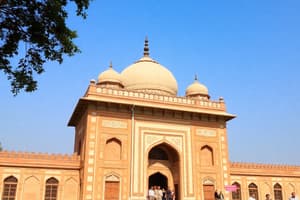Podcast
Questions and Answers
What was the primary purpose of imposing jizya (tax on non-Muslims) during Aurangzeb's reign?
What was the primary purpose of imposing jizya (tax on non-Muslims) during Aurangzeb's reign?
What was the primary function of the diwan (finance minister) in Aurangzeb's administration?
What was the primary function of the diwan (finance minister) in Aurangzeb's administration?
What was the main consequence of Aurangzeb's persecution of Hindus, Jains, and Sikhs?
What was the main consequence of Aurangzeb's persecution of Hindus, Jains, and Sikhs?
What was the primary purpose of introducing the mansabdari system?
What was the primary purpose of introducing the mansabdari system?
Signup and view all the answers
What was the result of Aurangzeb's expansion of the Mughal Empire?
What was the result of Aurangzeb's expansion of the Mughal Empire?
Signup and view all the answers
What was the main consequence of Aurangzeb's conflicts with the Marathas and Sikhs?
What was the main consequence of Aurangzeb's conflicts with the Marathas and Sikhs?
Signup and view all the answers
Study Notes
Aurangzeb
Religious Policies
- Prohibited construction of new Hindu temples and mosques
- Imposed jizya (tax on non-Muslims) to finance military campaigns
- Destroyed Hindu temples and idols, considering them as symbols of idolatry
- Banned Hindu festivals and celebrations, considering them as un-Islamic
- Persecuted Hindus, Jains, and Sikhs, leading to widespread conversions to Islam
- Promoted Islamic learning and education, establishing madrasas and rewarding scholars
Administrative Reforms
- Divided the empire into subahs (provinces), each governed by a subedar (governor)
- Established a centralized revenue system, with the diwan (finance minister) responsible for collecting taxes
- Introduced the mansabdari system, where officials were ranked based on their military and administrative responsibilities
- Strengthened the wazir (prime minister) position, making it responsible for overseeing administration and finance
- Established a network of roads, bridges, and serais (inns) to facilitate communication and trade
Mughal Empire
- Expanded the empire to its greatest extent, covering modern-day India, Pakistan, Bangladesh, and parts of Afghanistan
- Conquered the Deccan Sultanates, including Bijapur and Golconda
- Faced resistance from the Marathas, led by Shivaji, and the Sikhs, led by Guru Gobind Singh
- Engaged in a series of wars with the Portuguese, including the Siege of Bombay (1689-1690)
- Strengthened the Mughal army, introducing artillery and cavalry units, and promoting the use of cannons and matchlocks
Studying That Suits You
Use AI to generate personalized quizzes and flashcards to suit your learning preferences.
Description
Assess your knowledge of Aurangzeb's reign, including his religious policies, administrative reforms, and expansion of the Mughal Empire. Learn about his impact on Indian history and the legacy of his rule.




